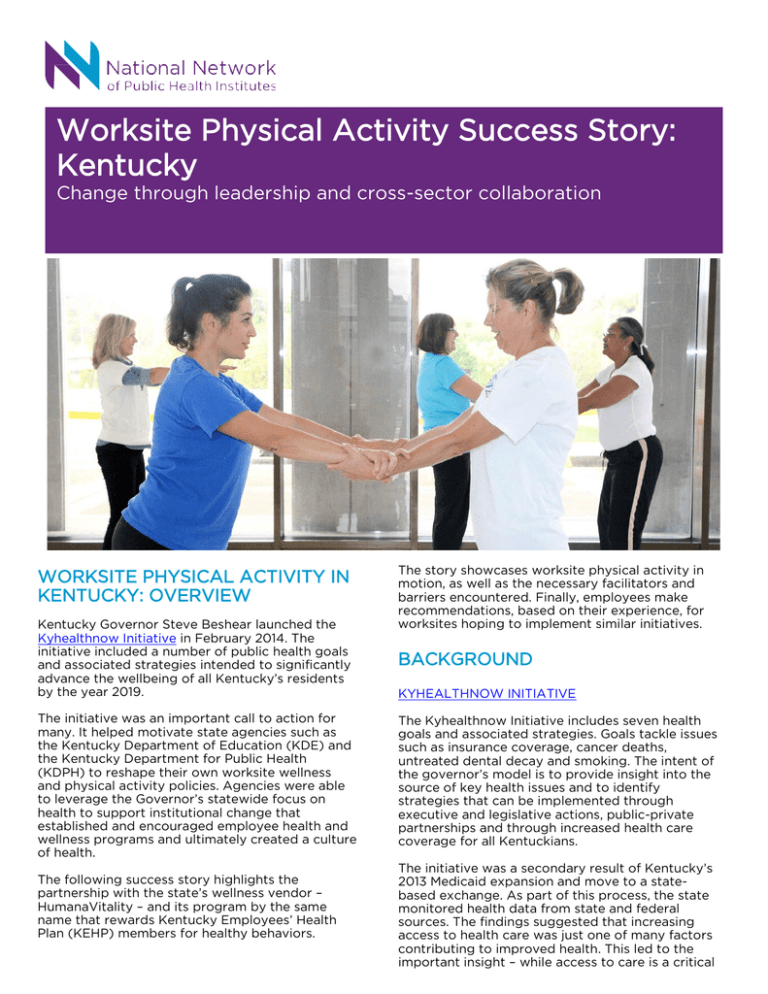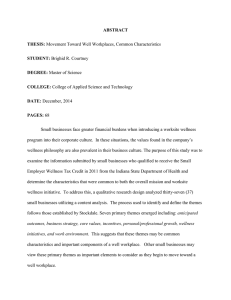Worksite Physical Activity Success Story: Kentucky Change through leadership and cross-sector collaboration
advertisement

Worksite Physical Activity Success Story: Kentucky Change through leadership and cross-sector collaboration WORKSITE PHYSICAL ACTIVITY IN KENTUCKY: OVERVIEW Kentucky Governor Steve Beshear launched the Kyhealthnow Initiative in February 2014. The initiative included a number of public health goals and associated strategies intended to significantly advance the wellbeing of all Kentucky’s residents by the year 2019. The initiative was an important call to action for many. It helped motivate state agencies such as the Kentucky Department of Education (KDE) and the Kentucky Department for Public Health (KDPH) to reshape their own worksite wellness and physical activity policies. Agencies were able to leverage the Governor’s statewide focus on health to support institutional change that established and encouraged employee health and wellness programs and ultimately created a culture of health. The following success story highlights the partnership with the state’s wellness vendor – HumanaVitality – and its program by the same name that rewards Kentucky Employees’ Health Plan (KEHP) members for healthy behaviors. The story showcases worksite physical activity in motion, as well as the necessary facilitators and barriers encountered. Finally, employees make recommendations, based on their experience, for worksites hoping to implement similar initiatives. BACKGROUND KYHEALTHNOW INITIATIVE The Kyhealthnow Initiative includes seven health goals and associated strategies. Goals tackle issues such as insurance coverage, cancer deaths, untreated dental decay and smoking. The intent of the governor’s model is to provide insight into the source of key health issues and to identify strategies that can be implemented through executive and legislative actions, public-private partnerships and through increased health care coverage for all Kentuckians. The initiative was a secondary result of Kentucky’s 2013 Medicaid expansion and move to a statebased exchange. As part of this process, the state monitored health data from state and federal sources. The findings suggested that increasing access to health care was just one of many factors contributing to improved health. This led to the important insight – while access to care is a critical milestone, it alone does not increase the health of 1 the population. Report). Workplace wellness, particularly physical activity, is supported by two of the Kyhealthnow goals: 1. Reduce the rate of obesity among Kentuckians by 10 percent. 2. Reduce cardiovascular deaths by 10 percent. The oversight committee identified the following promising strategies for addressing these goals: • • In 2013, the Cabinet for Health and Family Services, which oversees the Kentucky Department for Public Health, worked closely with the governor to brainstorm how to move forward. They reviewed all available data, relevant strategies and explored a number of programmatic options. In the planning process, the team identified its ultimate goal was to have real-time data with which to inform future policies while improving the health of all Kentuckians. The team researched pertinent health issues in the state, developed goals and strategies, and identified an implementation plan. Thus, the Kyhealthnow Initiative was born. • Ensure access for all state employees to the Diabetes Prevention Program, as part of HumanaVitality. Work with public and private workplaces to adopt healthy concessions and vending policies reflecting federal guidelines. Develop initiatives to honor and recognize businesses and schools that provide greater opportunities for physical activity. The Kyhealthnow Initiative created an infrastructure to support agencies such as the KDE and KDPH in achieving health and wellness among their employees and constituents. The initiative provides the necessary goals and strategies statewide to ensure they can be implemented and, ultimately, that sustainable change is made resulting in healthier Kentuckians. “An initial part of that [Kentucky Health Now Plan] … recognizes that…active and healthy employeesaremore productive.” HUMANAVITALITY® As mentioned, HumanaVitality is the wellness vendor for all state workers through the Kentucky Employees’ Health Plan, or KEHP. The plan incentivizes behavior such as exercise and preventive health exams. Activities are tracked and submitted via a Web application, and Vitality Points are awarded, which can be redeemed for items such as pedometers or gift certificates to various stores. As part of the call to action, the governor signed 2 Executive Order 2014-114 that established an oversight team. The team included the lieutenant governor, the commissioner of public health, and representatives from all state cabinets. The governor charged the team with overseeing all efforts to meet Kyhealthnow goals and carrying out the associated strategies. Also, the team was responsible for monitoring and reporting on statewide strategies (see the 2015 Annual 1 Information was garnered during an informal interview with Kentucky’s Health and PHYSICAL Family Services Secretary, Audrey UTAH WORKSITE ACTIVITY SUCCESS STORY Haynes For example, employees can earn points for participating in a biometrics screening that includes a check of blood pressure and glucose levels among other things. Another way to earn points is to track and report steps taken via devices such a Fitbit. One participant earned points by taking advantage of some of the outdoor walking trails available in and around the state capital of Frankfort to get in 10,000 steps a day. In some cases, incentives are contextualized to accommodate different professions. For example, teachers using HumanaVitality can earn points for engaging their students in exercise during school hours via a program called “Students with Active 2 “Wellness Week”. Individual organizations were given the flexibility to work independently to design, organize, and promote their own activities. After several weeks of advertisement and word of mouth communication, an employee-lead promotional video that provided background information and details about the forthcoming activities was used to kick-off the week. Role Models.” “It’s a whole lot easier to give you an Amazon.com gift card thanit is to pay foryour emergency room visit.” Furthermore, employees can earn status – bronze, silver, gold, or platinum – based on the total number of points. The status provides additional discounts on purchases. For example, if an employee wanted to purchase a gift card for 2,500 points, the employee could actually receive it for less points by being at the gold or platinum level. Overall, HumanaVitality incentives are meant to encourage employees to seek out opportunities that will improve their well-being. The idea is that the incentivized behaviors will ultimately become habitual for participants, leading to better long term health for themselves and their communities. KENTUCKY DEPARTMENT OF EDUCATION (KDE) Activities during the Wellness Week included 4 group exercise classes like Zumba and Cross Fit. Additionally some staff members participated in an organized outdoor hike. The department leveraged local partnerships and/or employee connections to bring in instructors free of charge, who were in turn able to capitalize on the time to advertise their own services. KDE oversees 173 school districts in all 120 3 counties with more than 80,000 teachers and many other employees dispersed throughout the state. The agency itself employs approximately 400 people. On May 1, 2015 Kentucky’s commissioner of education enacted a policy allowing all KDE employees to request permission from their supervisors to take 30 minutes of work time a day or up to 90 minutes a week to participate in physical activity. The impact of this policy could be significant. If half of KDE employees took advantage of the policy and exercised 90 minutes a week over the course of a nine-month school year, that would total more than 10,000 hours spent exercising during work hours. A number of events and a fundamental belief in the importance of physical wellness led to the adoption of the physical activity leave policy. The Kyhealthnow initiative provided a favorable political climate. The success of the contract with HumanaVitality also played a role by highlighting the potential gains possible through administrative policies. In addition, budget restrictions encouraged the KDE to offer incentives other than salary increases to keep employees and attract new ones. Wellness Week also included regular communications with tips on nutrition and physical fitness, as well as information about how to participate in the upcoming activities. Wellness Week encouraged offices, divisions and branches to maintain momentum by adapting strategies such as holding standing or walking meetings and by incorporating fitness and overall wellness into their infrastructure. FACILITATORS & BARRIERS FACILITATORS Kentucky’s success was facilitated by a number of important factors. Government Support Kentucky Department of Education employees credited the backing of the governor and commissioner as integral in creating a culture of worksite wellness and physical activity. WORKSITE PHYSICAL ACTIVITY IN MOTION Many organizations that fall within the Education and Workforce Development Cabinet host a full week of targeted wellness activities, supported by leadership and referred to as the agency’s UTAH WORKSITE PHYSICAL ACTIVITY SUCCESS STORY 3 http://education.ky.gov/comm/edfacts/Pages/default.aspx 4 3 Wellness Week participants were asked to sign a waiver to address concerns with potential liability issues. “While this [encouraging employees to exercise during work hours]may be new to government, it is not new to successful businesses.” Internal Issues Committee In 2011, the National Association of State Boards of Education, with money from the Robert Wood Johnson Foundation, awarded the Kentucky Board of Education funding to start a health subcommittee, comprised of representatives from each of the six offices within the Kentucky Department of Education. The committee oversees all health-related work with districts across the state and worksite activity within the department. The committee generally meets about every other month – potentially more often to plan large scale activities such as Wellness Week. Members are responsible for all wellness activities within the KDE. One employee explained that the committee was important because it represented the diverse needs of each office and could make decisions and organize events to benefit of the entire department. HumanaVitality The HumanaVitality program provides a structure for employees to learn new strategies to improve their wellness with an easy mechanism (via the mobile application) by which to keep track, earn points, and cash them in for gifts. BARRIERS Management Style In order for KDE employees to fully reap the benefits of the commissioner’s policy, it requires that the employee’s supervisor be informed and flexible. On a large-scale, one employee noted that some organizations may have a management structure not conducive to complying with a broad policy shift. RECOMMENDATIONS Employees were asked to share recommendations they had for organizations hoping to implement similar worksite physical activity initiatives. Recommendations included: • • • • • Ensure the focus is on the health and wellness of the employee to help achieve wide scale buy-in. Be patient and understand that significant change takes time. Be consistent and rely on research when communicating your message. Understand that success can only be achieved collectively. Seek out champions within the organization to help lead the charge. CONCLUSION Kentucky’s KDE and KDPH are making significant strides in worksite physical activity. With support from division leaders, the KDE implemented a progressive policy encouraging employees to prioritize their own health as well as that of their students. Both the KDE and KDPH are capitalizing on the benefits of the HumanaVitality Plan by supporting walking challenges and providing employees tools to facilitate walking and other forms of exercise. Representatives from both agencies anticipated they would continue to move in the right direction and, hopefully, expand programs as buy-in and subsequent culture change is achieved. For more information on worksite physical activity in the Kentucky Department of Education please contact: Jamie R. Sparks School Health and Physical Education (SHAPE) Director Kentucky Department of Education jamie.sparks@education.ky.gov “Getting those systems to change can be very challenging because I think a lot of government systems tend to …offer anorganizational structure that calls for micromanaging.” Lack of Education Despite the agency wide physical activity policy and HumanaVitality Incentive system, there was still an identified gap in comprehensive education UTAH WORKSITE PHYSICAL around the importance ofACTIVITY physicalSUCCESS activity.STORY 4 This publication was made possible by support from the Division of Nutrition, Physical Activity and Obesity (DNPAO), Physical Activity and Health Branch in CDC’s National Center for Chronic Disease Prevention & Health Promotion (NCCDPHP), through Cooperative Agreement Number U38OT00020. Its contents are solely the responsibility of the authors and do not necessarily represent the official views of the Centers for Disease Control and Prevention. About the National Network of Public Health Institutes Created in 2001 as a forum for public health institutes (PHIs), today the National Network of Public Health Institutes (NNPHI) convenes its members and partners at the local, state, and national levels in efforts to address critical health issues. NNPHI’s mission is to support national public health system initiatives and strengthen PHIs to promote multi-sector activities resulting in measurable improvements of public health structures, systems, and outcomes. Learn more at www.nnphi.org. UTAH WORKSITE PHYSICAL ACTIVITY SUCCESS STORY 5




